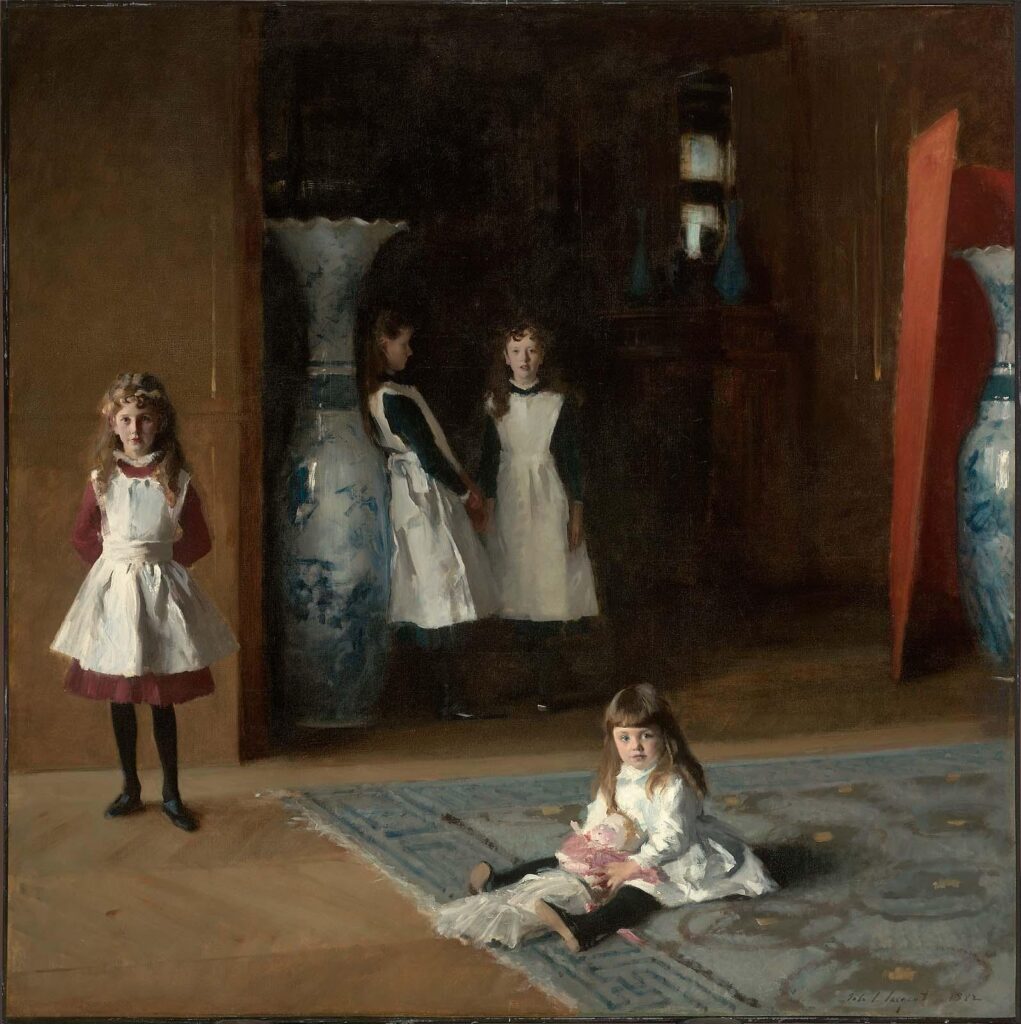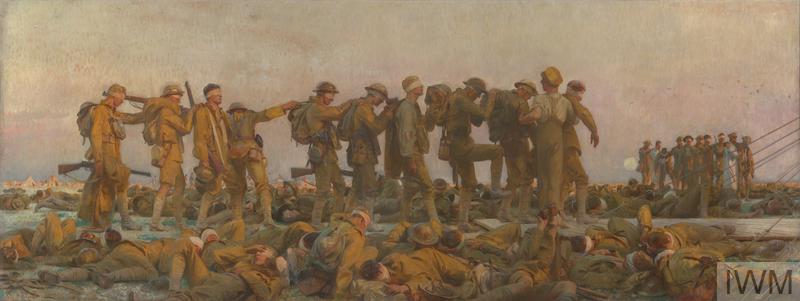John Singer Sargent was born on January 12, 1856 and was the eldest of the surviving Sargent children. His parents were Dr. Fitzwilliam Sargent and Mary Newbold Singer. His father was a doctor in Philadelphia but left America in 1854 to live in Europe after the death of their first child Mary. The couple would return to America on short visits. John had two younger sisters, Emily and Violet. In the winter months, the family would live in Nice or Italy, and in the Summer they would live in the Alps. Throughout his childhood, John was exposed to art and spoke four languages. Fitzwilliam wanted his son to join the navy, but accepted that John wanted to pursue art. At 18, John moved to Paris to study art under Carolus-Duran and at the Ecole des Beaux-Arts. As a student of Carolus-Duran, John learned the au premier coup technique. This technique was to paint on the canvas with a full coating of paint. John was selected to assist Carolus-Duran for his work for the ceiling for the Luxembourg Palace, Gloria Mariae Medici. In the ceiling, there were portraits of John and Duran, which are now housed in the Louvre. After completing the ceiling, Carolus-Duran sat for a portrait by John. This painting would be his first official portrait at an exhibition at the Paris Salon. Following in the footsteps of Carolus-Duran, John went to Spain to copy the works of Spanish painter Diego Velazquez. He then went to Holland to study the work of Frans Hals.


In 1877, John submitted work for an exhibition at the Salon. The work consisted of portraits and subject paintings. His art garnered critical acclaim which was rare for an American artist. An early painting, Oyster Gatherers of Cançale, depicted a fishing community in Brittany which led to numerous landscape paintings in his career. Also in 1877, John started subject pictures based on his travels. His early period also includes, El Jaleo, Fumée d’ambre gris and The Daughters of Edward Darley Boit. El Jaleo, was created while Sargent was in Spain. He was fascinated in Spanish dance and music as shown in the painting. After finishing El Jaleo, Sargent picked up his piano playing and was a supporter of modern music including Gabriel Faure. Debuting at the Paris Salon, the painting was purchased by Thomas Jefferson Coolidge who’s cousin Isabella Stewart Gardner wanted him to loan it to her. His other notable painting, The Daughters of Edward Darley Boit, was created in the foyer of the Boit’s Paris apartment. At the time, many critics thought it was strange to have some of the girls out of the main area. Others said that this piece was heavily influenced by Velazquez’s Las Meninas. Both paintings have strong geometric shapes and alignments. The paintings also share dark coloring.
John was named an honorary mention in 1897 for his portrait of Carolus-Duran and in 1881, a second place medal for a portrait of Madame Ramon Subercaseaux. Between 1880 and 1882, Sargent lived in Venice and captured scenes that highlight more the Venetian atmosphere outside of the tourist spots. Some of the works feature enclosed spaces such as alleyways.


Returning to Paris, Sargent moved into his first studio and began to establish himself in a new period. It was in this new period of his career that he painted his most famous piece, The Painting of Madame X. The subject in this work is Madame Pierre Gautreau, an American woman living in Paris. Gautreau was known to have eccentric looks which caught the interest of Sargent. Sargent requested Gautreau be the subject of this work. The work was intended to be about opposition for example the black dress with the jeweled straps. Though he received praise in his first exhibition at the Paris Salon, when Sargent revealed Madame X in 1884, it caused a scandal. On the day of its premiere, French women cried out “where is the beauty, how horrible”. More negative reviews came in the following days. Critics complained about the pale color of the skin, the sexuality and the placement of the dress straps. Madame Gautreau complained that the finished product was different from the one she was posing for. Her mother wrote to Sargent to remove it from the Salon. Due to this incident, John left Paris for London. However, Madame X might have been helpful in establishing a career in America and England.
In England, John was quickly hired to paint members of the Vickers family. He also was introduced to author Henry James. James referred to Sargent as being energetic and popular with the society. James would write about their friendship in Harper’s Magazine, the oldest published monthly magazine. Sargent lived in James Whistler’s former London studio. While the desire for portraits declined, Sargent focused on English landscapes and impressionism. One of his big English works is Carnation, Lily, Lily, Rose. Painted in the Cotswold area, Sargent used the daughters of his friend, Frederick Bernard. It is believed that Sargent also was inspired by Robert Louis Stevenson’s A Child’s Garden of Verses. Stevenson was also visiting Bernard at the same time Sargent came.
Sargent returned to portraits in 1887, on one of his first trips back to America, He was hired to paint the wife of Henry G. Marquand at their Newport residence. When Sargent arrived in Rhode Island, he was warmly welcomed and Marquand toured him around Boston. Bostonian society immediately took a shine to Sargent and gave him his own show at the Botolph Club. His friend, Henry Boit also introduced Sargent to other prominent Boston figures, Charles Fairchild and Isabella Stewart Gardener. Sargent found work through his network of friends and was commissioned with painting a mural on the Boston Public Library(now in the original structure). By 1890, Sargent produced more than forty portraits. Sargent was welcomed at the Royal Academy when Lord Leighton joined the Board. With Leighton’s public support, Sargent became friends with Asher Wertheimer, who also became his greatest patron. Wertheimer gave his paintings to the National Gallery in London (Tate Gallery). At the turn of the century, Sargent expanded his subjects to Edwardian nobility. Sargent continued to travel and paint around Europe until the outbreak of World War I. While the war raged in Europe, Sargent painted around the American landscape and parts of Canada. The Museum of Fine Arts in Boston, commissioned Sargent to create portraits of President Woodrow Wilson and John D. Rockefeller. Sargent’s last great work was in 1919. He returned to Europe and accepted a job that put him at the western front. The subject of Gassed is the aftermath of soldiers from a Mustard Gas attack.

Sargent died on April 14th 1925 in England from heart disease. He never married but kept a close circle of friends throughout his life. Memorial exhibitions were held in Boston, London and New York.


Recent Comments